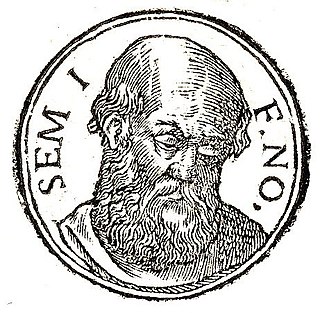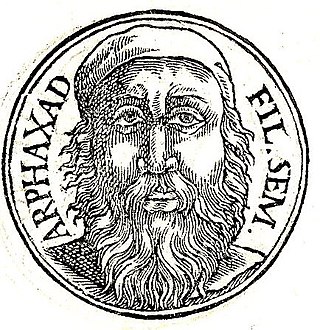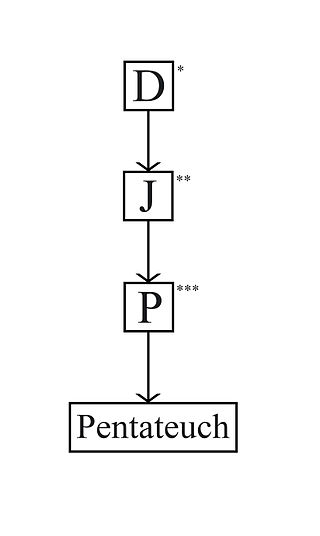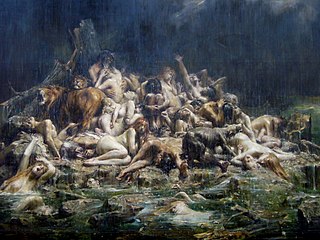The Book of Exodus is the second religious book of the Bible. It is a narrative of the Exodus, the origin myth of the Israelites leaving slavery in Biblical Egypt through the strength of their deity named Yahweh, who according to the story chose them as his people. The Israelites then journey with the legendary prophet Moses to Mount Sinai, where Yahweh gives the 10 commandments and they enter into a covenant with Yahweh, who promises to make them a "holy nation, and a kingdom of priests" on condition of their faithfulness. He gives them their laws and instructions to build the Tabernacle, the means by which he will come from heaven and dwell with them and lead them in a holy war to conquer Canaan, which has earlier, according to the myth of Genesis, been promised to the "seed" of Abraham, the legendary patriarch of the Israelites.
The Book of Genesis is the first book of the Hebrew Bible and the Christian Old Testament. Its Hebrew name is the same as its first word, Bereshit. Genesis is an account of the creation of the world, the early history of humanity, and the origins of the Jewish people.

Japheth is one of the three sons of Noah in the Book of Genesis, in which he plays a role in the story of Noah's drunkenness and the curse of Ham, and subsequently in the Table of Nations as the ancestor of the peoples of the Aegean Sea, Anatolia, and elsewhere. In medieval and early modern European tradition he was considered to be the progenitor of the European peoples, while Islamic traditions also include the Chinese people among his descendants.

Noah appears as the last of the Antediluvian patriarchs in the traditions of Abrahamic religions. His story appears in the Hebrew Bible, the Quran and Baha'i writings. Noah is referenced in various other books of the Bible, including the New Testament, and in associated deuterocanonical books.

Shem was one of the sons of Noah in the Bible and the Quran.

The Torah is the compilation of the first five books of the Hebrew Bible, namely the books of Genesis, Exodus, Leviticus, Numbers and Deuteronomy. The Torah is known as the Pentateuch or the Five Books of Moses by Christians. It is also known as the Written Torah in Jewish tradition. If meant for liturgic purposes, it takes the form of a Torah scroll. If in bound book form, it is called Chumash, and is usually printed with the rabbinic commentaries.

The documentary hypothesis (DH) is one of the models used by biblical scholars to explain the origins and composition of the Torah. A version of the documentary hypothesis, frequently identified with the German scholar Julius Wellhausen, was almost universally accepted for most of the 20th century. It posited that the Pentateuch is a compilation of four originally independent documents: the Jahwist (J), Elohist (E), Deuteronomist (D), and Priestly (P) sources. The first of these, J, was dated to the Solomonic period. E was dated somewhat later, in the 9th century BCE, and D was dated just before the reign of King Josiah, in the 7th or 8th century BCE. Finally, P was generally dated to the time of Ezra in the 5th century BCE. The sources would have been joined together at various points in time by a series of editors or "redactors".

The Generations of Noah, also called the Table of Nations or Origines Gentium, is a genealogy of the sons of Noah, according to the Hebrew Bible, and their dispersion into many lands after the Flood, focusing on the major known societies. The term nations to describe the descendants is a standard English translation of the Hebrew word "goyim", following the c. 400 CE Latin Vulgate's "nationes", and does not have the same political connotations that the word entails today.

Noah's Ark is the ship in the Genesis flood narrative through which God spares Noah, his family, and examples of all the world's animals from a global deluge. The story in Genesis is based on earlier flood myths originating in Mesopotamia, and is repeated, with variations, in the Quran, where the Ark appears as Safinat Nūḥ and al-fulk.

In the biblical Book of Genesis, Cain and Abel are the first two sons of Adam and Eve. Cain, the firstborn, was a farmer, and his brother Abel was a shepherd. The brothers made sacrifices to God, but God favored Abel's sacrifice instead of Cain's. Cain then murdered Abel, whereupon God punished Cain by condemning him to a life of wandering. Cain then dwelt in the land of Nod, where he built a city and fathered the line of descendants beginning with Enoch.

Arpachshad, alternatively spelled Arphaxad or Arphacsad, is one of the postdiluvian men in the Shem–Terah genealogy. The name is recorded in the Book of Genesis in the Hebrew Bible and subsequently copied in different biblical books, including the Gospel of Luke in the New Testament.
The Genesis creation narrative is the creation myth of both Judaism and Christianity. The narrative is made up of two stories, roughly equivalent to the first two chapters of the Book of Genesis. In the first, Elohim creates the heavens and the Earth in six days, then rests on, blesses, and sanctifies the seventh. In the second story God creates Adam, the first man, from dust and places him in the Garden of Eden. There he is given dominion over the animals. Eve, the first woman, is created from Adam's rib as his companion.
The genealogies of Genesis provide the framework around which the Book of Genesis is structured. Beginning with Adam, genealogical material in Genesis 4, 5, 10, 11, 22, 25, 29–30, 35–36, and 46 moves the narrative forward from the creation to the beginnings of the Israelites' existence as a people.

According to the documentary hypothesis, the Elohist is one of four source documents underlying the Torah, together with the Jahwist, the Deuteronomist and the Priestly source. The Elohist is so named because of its pervasive use of the word Elohim to refer to the Israelite God.

The Jahwist, or Yahwist, often abbreviated J, is one of the most widely recognized sources of the Pentateuch (Torah), together with the Deuteronomist, the Priestly source and the Elohist. The existence of the Jahwist is somewhat controversial, with a number of scholars, especially in Europe, denying that it ever existed as a coherent independent document. Nevertheless, many scholars do assume its existence. The Jahwist is so named because of its characteristic use of the term Yahweh for God.

The five books of the Torah are formed by three kinds of sources: Deuteronomist (D), Priestly (P), and those which are not (P) or (D). The Priestly source (or simply P) is considered by most scholars as the latest of all sources, and “meant to be a kind of redactional layer to hold the entirety of the Pentateuch together,” but perhaps the most widely recognized of the sources underlying the Torah, both stylistically and theologically distinct from other material in it. It includes a set of claims that are contradicted by non-Priestly passages and therefore uniquely characteristic: no sacrifice before the institution is ordained by Yahweh (God) at Sinai, the exalted status of Aaron and the priesthood, and the use of the divine title El Shaddai before God reveals his name to Moses, to name a few.

Adam and Eve, according to the creation myth of the Abrahamic religions, were the first man and woman. They are central to the belief that humanity is in essence a single family, with everyone descended from a single pair of original ancestors. They also provide the basis for the doctrines of the fall of man and original sin that are important beliefs in Christianity, although not held in Judaism or Islam.

The Genesis flood narrative is a Hebrew flood myth. It tells of God's decision to return the universe to its pre-creation state of watery chaos and remake it through the microcosm of Noah's ark.

In biblical studies, the supplementary hypothesis proposes that the Pentateuch was derived from a series of direct additions to an existing corpus of work. It serves as a revision to the earlier documentary hypothesis, which proposed that independent and complete narratives were later combined by redactors to create the Pentateuch.
The composition of the Torah was a process that involved multiple authors over an extended period of time. While Jewish tradition holds that all five books were originally written by Moses sometime in the 2nd millennium BCE, leading scholars have rejected Mosaic authorship since the 17th century.












